#arzamas-16
Text

Making the Monument to the Builders of the City designed by Gennady Yastrebov (Arzamas-16, USSR, 1986)
160 notes
·
View notes
Text
“The flash alone lasted more than a minute. The fireball expanded to nearly six miles in diameter—large enough to include the entire urban core of Washington or San Francisco, or all of midtown and downtown Manhattan. Over several minutes it rose and mushroomed into a massive cloud. Within ten minutes, it had reached a height of 42 miles and a diameter of some 60 miles. One civilian witness remarked that it was “as if the Earth was killed.” Decades later, the weapon would be given the name it is most commonly known by today: Tsar Bomba, meaning “emperor bomb.”
Designed to have a maximum explosive yield of 100 million tons (or 100 megatons) of TNT equivalent, the 60,000-pound monster bomb was detonated at only half its strength. Still, at 50 megatons, it was more than 3,300 times as powerful as the atomic bomb that killed at least 70,000 people in Hiroshima, and more than 40 times as powerful as the largest nuclear bomb in the US arsenal today. Its single test represents about one tenth of the total yield of all nuclear weapons ever tested by all nations.
(…)
The Tsar Bomba is not just a subject for history; some of the same dynamics exist today. It is not just the story of a single weapon that was detonated six decades ago, but a parable about political posturing and technical enablement that applies just as acutely today. In a new era of nuclear weapons and delivery competition, the Tsar Bomba is a potent example of how nationalism, fear, and high-technology can combine in a fashion that is ultimately dangerous, wasteful, and pointless.
(…)
Only a few months later, in July 1954, Teller made it clear he thought 15 megatons was child’s play. At a secret meeting of the General Advisory Committee of the Atomic Energy Commission, Teller broached, as he put it, “the possibility of much bigger bangs.” At his Livermore laboratory, he reported, they were working on two new weapon designs, dubbed Gnomon and Sundial. Gnomon would be 1,000 megatons and would be used like a “primary” to set off Sundial, which would be 10,000 megatons. Most of Teller’s testimony remains classified to this day, but other scientists at the meeting recorded, after Teller had left, that they were “shocked” by his proposal. “It would contaminate the Earth,” one suggested. Physicist I. I. Rabi, by then an experienced Teller skeptic, suggested it was probably just an “advertising stunt.”[4] But he was wrong; Livermore would for several years continue working on Gnomon, at least, and had even planned to test a prototype for the device in Operation Redwing in 1956 (but the test never took place).
All of which is to say that the idea of making hydrogen bombs in the hundreds-of-megatons yield range was hardly unusual in the late 1950s. If anything, it was tame compared to the gigaton ambitions of one of the H-bomb’s inventors. It is hard to convey the damage of a gigaton bomb, because at such yields many traditional scaling laws do not work (the bomb blows a hole in the atmosphere, essentially). However, a study from 1963 suggested that, if detonated 28 miles (45 kilometers) above the surface of the Earth, a 10,000-megaton weapon could set fires over an area 500 miles (800 kilometers) in diameter. Which is to say, an area about the size of France.
(…)
Exactly how the idea of the 100-megaton device came up at this meeting is not entirely clear from the accounts, but it sounds like Khrushchev asked the scientists for proposals for future tests, and somebody (some authors say it was Trutnev) proposed that they build and detonate a 100-megaton bomb. Khrushchev seized upon the idea, reportedly announcing: “Let the 100-megaton bomb hang over the capitalists like a sword of Damocles!”[12]
Later Russian accounts by participants claim Arzamas-16 scientists had been inspired, in part, by speculations about gigantic, gigaton-range bombs in the foreign press in May 1960. The physicist and designer Victor Adamski said that Sakharov and others tried to immediately assess the plausibility of the news reports, and came up with the schema that was ultimately used for the Tsar Bomba. They had initially apparently planned to design a smaller experiment, but they had somehow come across the preserved casing from the aborted RDS-202 bomb from 1956. The vastness of it apparently inspired them to go for a full-size test. But unlike the 1956 plan, they would use the newest Project 49 insights in developing this new bomb, making it far more sophisticated than a simple scaling-up of an old design; it would be over twice as powerful as RDS-202, despite being the same dimensions and weight.[13] Sakharov, in his memoirs, said he had been thinking about “the initiative,” as he called it, well before any formal request was made. It was not just about the megatonnage for its own sake; it would need to be “an absolute record,” so that, perhaps, it would be the last series of atmospheric tests ever requested.[14]
The 100-megaton bomb would be known internally as Project 602. The speed of its development is beyond impressive in retrospect: In a mere four months, the team would have to develop an entirely new weapon design for a totally untested yield range; build the device and fabricate the fissionable and fusionable material into the correct shapes; and devise a plan to safely test it. Sakharov would manage the whole project, with Trutnev and Babaev doing much of the design work, along with the young physicists Victor Adamski and Yuri Smirnov. Little has been released about the details of the design, but a few years ago two longtime participants in the Soviet and Russian nuclear programs revealed that it was what they called a “bifilar” design: There was a “main” thermonuclear unit in the center, with two “primaries” imploding it from either side (with a time difference between the two detonations of no more than 0.1 microseconds).[15] This seems plausible given the documentary photographs of the bomb released by Russia after the Cold War, which definitely show one very compact “primary” bomb at the front end of the case, and hint at another at the back of the case. If this is true, it suggests that the 100-megaton bomb design was quite different from most thermonuclear weapons; there has never been a report of any American bombs, for example, that use multiple, simultaneous primaries.
(…)
Sakharov also made one major change to the test plan. Even though the test bomb was a 100-megaton design, it would not be a 100-megaton detonation. In most thermonuclear weapons designs, at least half the yield comes from a final stage in which non-fissile atoms of uranium 238 are induced to fission by the high-energy neutrons produced by deuterium-tritium fusion reactions. Replacing the uranium 238 with an inert substance, in this case lead, would make the weapon half as powerful (50 megatons), and it would release far less fallout in the form of fission products.
Sakharov was already queasy about the long-term deaths from nuclear fallout, and he wanted to minimize the excess radioactivity produced by the test. In 1958, he had calculated that for every megaton of even “clean” nuclear weapons, there would be some 6,600 premature deaths over the next 8,000 years across the globe, owing to carbon atoms in the atmosphere that would become radioactive under the bomb’s neutron flux.[17]
A few thousand deaths—even the 660,000 that he thought would be the result of a 100-megaton test—would be a tiny amount compared with the billions who would live and die over those millennia, but they were still deaths Sakharov considered himself partially responsible for. Had he not reduced its yield by half, the 100-megaton bomb would have contributed about half as many fission products as were released by all nuclear tests prior to the test moratorium. As it was, even a bomb that was only 3 percent fission wasn’t exactly clean in an objective sense—as it still released almost two megatons of fission products. But in a relative sense (comparing fission yield to total yield), it was one of the cleanest nuclear weapons ever tested. Again, Sakharov would later state that he believed that if this worked, it could essentially end atmospheric nuclear testing: The Soviets would be able to “squeeze everything out of this [testing series] so that it would be the last one.”
(…)
The Soviet hints of 100-megaton bombs provoked furious speculation in American newspapers, which reported unattributed sources saying that the United States could, if it wanted to, build and test 100-megaton weapons of its own, but that it chose not to. Some American scientists chimed in that weapons of such size were “too big” to be practical—that such a weapon would be strategically pointless. The argument, which would come up again and again in discussion of these bombs, was based on the way in which blast damage scales with yield. A 100-megaton bomb releases 10 times more energy than a 10-megaton bomb, but it does not do 10 times more damage. This is because the blast effects of explosions scale as a cubic root, not linearly. So a 10-megaton bomb detonated at an optimal altitude might do medium damage to a distance of 9.4 miles (15 kilometers) from ground zero, but a 100-megaton bomb “only” does the same amount of damage to 20.3 miles (33 kilometers). In other words, a 100-megaton explosion is only a little more than twice as damaging as a 10-megaton bomb. The weight of nuclear weapons, though, does roughly scale with their yield in a more linear fashion (design sophistication can vary this a bit), so a 100-megaton bomb weighs roughly 10 times more than a 10-megaton bomb, which makes it much more difficult to deploy on a bomber or missile.
(…)
Sakharov and most of the weapons designers were not at the test, but they knew it worked because the detonation disrupted radio communications with the test site for 40 minutes. Despite being detonated low enough (about 13,000 feet) to be at risk of contacting the ground and creating significant local fallout, the blast wave “bounced” the fireball of the bomb upward. As a result, almost all the fallout shot into the stratosphere, where it would circle in the northern latitudes for years before coming down.
(…)
A few months after Sputnik, in 1958, the US Air Force Chief of Staff asked the AEC for a feasibility study of even larger weapons—between 100 and 1,000 megatons in yield. As an internal, once-secret Air Force history from 1967 reported: “The Air Staff concluded that it might be feasible but not desirable to use a 1,000-megaton weapon. Since lethal radioactivity might not be contained within the confines of an enemy state and since it might be impractical to even test such a weapon, the Air Force Council decided in April 1959 to postpone establishing a position on the issue.”[30] Let that sink in: These were weapons too large for even the Eisenhower-era Air Force.
(…)
A few days later, Seaborg met with weapons scientists to discuss building high-yield weapons. Betts initiated a discussion with Sandia National Laboratory over the feasibility of dropping weapons with yields of 30 or 50 megatons from a B-52, which would require using drogue parachutes to ensure the survival of the pilots. At the same time, a team of Livermore scientists got together to review the possibilities of a US return to nuclear testing. Along with ideas relating to more optimized designs and “clean” bombs deriving most of their yield from fusion, they were intrigued once again by Teller’s possibility of bigger bangs: “USSR high-yield tests have reawakened interest in high-yield testing by the United States. High-yield weapons (50 megatons to 1,000 megatons) should be reconsidered and re-evaluated for their possible military use.”[34] Again, let that sink in: Even after denouncing the Tsar Bomba as pointless terrorism, there were scientists and military planners working for the US government who were considering nuclear weapons with yields 20 times larger.
(…)
The Limited Test Ban Treaty was beginning to take shape at this time, with a very real possibility that the United States and Soviet Union would agree to ban all atmospheric nuclear testing. Underground testing, which the United States had demonstrated in 1961, would continue. But underground testing is limited to relatively low yields: To avoid “venting,” the fireball must be entirely contained underground—and an enormous fireball would require an enormous hole in the ground. (To put it into perspective: The fireball for a 50-megaton weapon has a radius of about 3 miles. The deepest active mine in the world is 2.5 miles deep, and the deepest hole in the world is only about 4 miles deep. Even the world’s highest mountain is only 5.5 miles tall.)
(…)
But the Soviets never broke the Limited Test Ban Treaty, and smaller warheads became the norm. Warheads that could be mounted in multiples and independently targeted on a single missile, or put into submarines, became the core of the arsenal. Large, high-yield weapons would, eventually, be mostly phased out. The dismissal of the uselessness of the Tsar Bomba would become orthodoxy, as even the CIA (eventually) concluded that the Soviets were not going to field such a thing in numbers or try to put superbombs on missiles.
(…)
Are the days of the 100-megaton bomb gone for good? One would hope so—though it has been speculated that the Russian Poseidon nuclear-powered drone-torpedo might carry some kind of “very high-yield” charge (reminiscent of a proposal Sakharov made after the successful Tsar Bomba test) as part of its attempt to maintain a credible (and terrifying) deterrence against US ballistic missile defenses. Such a weapon, detonated at sea level, would not only be incredibly devastating to a targeted port and the areas around it, but would, unlike the air-bursted Tsar Bomba, release a swath of deadly radioactive contamination that could cover hundreds of thousands of square miles.
But even if such weapons are now purely relegated to history, we should remember that the decision not to deploy them was not made because the Soviet Union and United States shied away from the shocking megatonnage. It was because massive bombs were harder to use, and something about them symbolized the ridiculousness of the arms race in a way that making thousands of “smaller” weapons (some as big as 20–30 megatons) did not.
The United States did not make 50- to 100-megaton bombs or gigaton bombs, but it made a gigaton arsenal: At its peak in 1960, the US stockpile was some 20,000 megatons, dispersed across tens of thousands of weapons. Even with trends toward miniaturization, it was not until the early 1990s that the US arsenal dropped beneath 5,000 megatons. Today it is probably around 2,000 megatons—more than enough to devastate the planet in a full-scale nuclear war.
The Tsar Bomba is dead; long live the Tsar Bomba. As the United States, Russia, and China seem to be engaged in new arms races in several domains, including unusual and new forms of nuclear delivery vehicles, the Tsar Bomba is a potent example of how nationalism, fear, and high-technology can combine in a fashion that is ultimately dangerous, wasteful, and pointless. “Very high-yield” nuclear weapons weren’t necessary for deterrence, and they were explored at the expense of not only other weapons systems, but also the multitude of other things that nations could spend their wealth and resources on. They didn’t bring safety or security.”
“The notion of a small nuclear war was offered as an alternative to the policy of “massive retaliation” identified with John Foster Dulles, President Dwight Eisenhower’s Secretary of State, which held that an aggressor state risked an atomic barrage, language that in the thermonuclear age carried with it a suggestion of total annihilation. Kissinger was too clever to let himself be trapped by any thesis, even his own, and he couched his “strategic doctrine” in qualified, antiseptic language. “The tactics for limited nuclear war should be based on small, highly mobile, self-contained units, relying largely on air transport even within the combat zone,” he wrote. The right model for a limited nuclear war was, he said, naval strategy, “in which self-contained units with great firepower gradually gain the upper hand,” with the effect of keeping “the enemy constantly off balance.” In a triumph of understatement, he added that this “will require a radical break with our traditional notions of warfare and military organizations.”
(…)
Indeed, in a world with more than fifteen thousand nuclear weapons—more than four thousand deployed on warheads—nukes are never really off the table. Many years ago, Herman Kahn, a rand Corporation expert on thermonuclear war, liked to ask, “How many American dead would we accept as the cost of our retaliation?” He’d mulled that question with many Americans, he wrote (in “The Nature and Feasibility of War and Deterrence”), “and after about fifteen minutes of discussion their estimates of an acceptable price generally fall between ten and sixty million dead. Their temporary first reaction, incidentally, usually is that the United States would never be deterred from living up to its obligations by fear of a Soviet counterblow, an attitude that invariably disappears after some minutes of reflection.””
#tsar bomba#nuclear weapons#russia#soviet union#america#ukraine#nuclear war#kissinger#henry kissinger
8 notes
·
View notes
Text
Tsar bomb
The Tsar Bomba (Russian: Царь-бо́мба) (code name: Ivan[5] or Vanya), also known by the alphanumerical designation "AN602", was a thermonuclearaerial bomb, and the most powerful nuclear weapon ever created and tested. Overall, the Soviet physicist Andrei Sakharov oversaw the project at Arzamas-16, while the main work of design was by Sakharov, Viktor Adamsky, Yuri Babayev, Yuri Smirnov, and Yuri Trutnev. The project was ordered by Nikita Khrushchev in July 1961 as part of the Soviet resumption of nuclear testing after the Test Ban Moratorium, with the detonation timed to coincide with the 22nd Congress of the Communist Party of the Soviet Union.[6]

1 note
·
View note
Note
At this point I don't care if Red's N-13 or Arzamas-16. If he stole the Fulcrum 2.0 (or whatever the name of this archive is) or the Fulcrum stole him. If Katarina's a spy, a myth or the Holy Spirit of this show.
I don't care about any answers and honestly? I don't think I ever did.
The only thing that matters to me in regards to those answers is that Red has no blood relation to Liz, so Lizzington and Agnesgate can be canon (I don't say real because they already are in our imagination and lots of wonderful fics).
And I don't think I'm the only one who holds such an opinion regarding those scary AnSwErS, yet TPTB don't seem to notice...
LMAO 😂 Honestly, anon, this ask is such a mood 😭 Listen, I'm with you. I'm a 🎶 basic bitch 🎶 & I 👏 ain't 👏 here 👏 for 👏 no 👏 plot 👏 That ship (so to speak lolz) sailed a loooooong time ago. I don't really care about all the mythology & shit, which is super sad bc I feel like I would care more if what we've been spoon-fed up to now was just more consistent. If it wasn't all so convoluted & contradictory & plot-hole-filled & retconned, I would probably give more of a shit. But, anticipating Wednesday's ep?? I'm just going in expecting the worst, expecting nothing to make sense in light of the very few "answers" we gotten before. I mean, there's so many little plotlines they've seemingly dropped like hot potatoes (i.e. Red's Christmas eve story, bubble girl, ballerina girl, etc.) I mean, who knows, they could pull it out of the hat & surprise the fuck outta us & tie it all together with a nice little bow which would be super weird considering they have at least another season left?? Am I the only one who feels all the "answers" promo & drama leading up to these last 2 eps is weird for a... NOT series finale?? Just me?? ... They could. We'll see. But again. What am I watching for? ANYTHING they decide to "reveal" that could sink Lizzington (or ruin Agnesgate), meaning any sort of ridiculous blood relation that could ruin our already-pretty-much-AU experience of shipping Lizzington. Bc I agree - Lizzington & Agnesgate already live in our hearts & imaginations & fics - but it would be a horrible feeling to find that they decided to retcon & officially sink the ship beyond salvaging in canon & make the show not worth watching anymore to us. So, fingers crossed that they, you know... don't do that 🥺🥺🥺 So, rest assured, you're definitely not alone, anon, whether TPTB notice or not!! 😓 Anyway, thank you for sending this along, I feel very validated!! 🥰 Much love to you, of course!! ❤️
#The Blacklist#Lizzington#TPTB#agnesgate#8.21#8.22#mine#ask#anon#ughhhhh i agreeeeeee#-.-'#thank you anon!!#:)#much love!!#<3
17 notes
·
View notes
Text
Highlighted by Chernobyl. Part 1.
This article is my review on a book «Valery Legasov: Highlighted by Chernobyl. History of the Chernobyl disaster in the notes of academician Legasov and in modern interpretation».
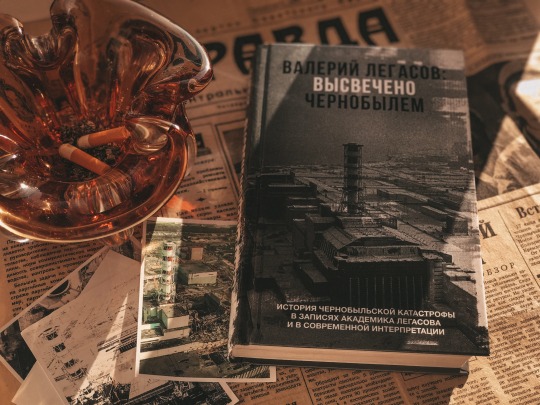
First of all, I apologize for being a lazy ass, a very busy person, since I’ve been promising some of you to write this book review for ages.
Also, in a post about how I bought this book, I mistakenly called it only Legasov's printed notes, but this book does not consist only of them.
The book is in three parts. And the first part really is Legasov's notes about the first days of the accident and the subsequent work in Chernobyl, which he wrote shortly before his death. These notes can also be found in English. As we know, they were published by Gubarev in the PRAVDA newspaper in an short-hand form on May 20, 1988. I will not go into much detail on this part of the book.
Also, the first part contains three articles by Valery Legasov, published in his lifetime: “Through the prism of Chernobyl. Conversation with Academician V.A. Legasov "(Pravda, September 5, 1986), "Highlighted by Chernobyl "(Chemistry and Life, 1987)," Problems of the Safe Development of the Technosphere "(Communist, 1987) Articles in which he also talks about the causes and consequences of the the Chernobyl accident, and also expresses concern about the state of large technological facilities in the USSR, and what measures need to be taken to create a separate institute of safety.
The book contains quite a lot of pictures that I haven't seen before, as well as photos of newspaper clippings that covered the events of the disaster and the progress of its elimination.

Through the prism of Chernobyl. Conversation with academician V.A. Legasov
General view of the destroyed Unit 4 of ChNPP. May, 1986

Radiation situation in a contaminated area based on helicopter survey results May 10, 1986
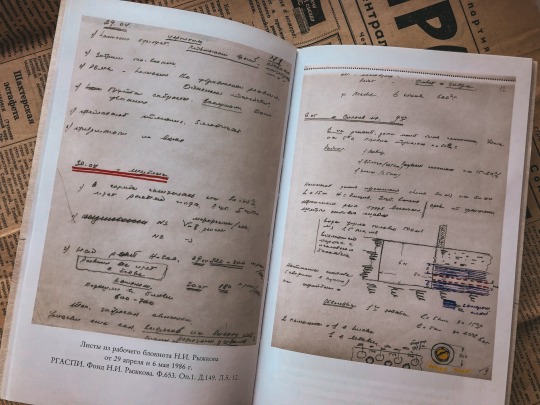
From N.I. Ryzhkov’s notebook from April 29 and May 6 1986

Deactivation of the area in the accident zone using a helicopter. May 1986
Ryzhkov N.I. (2-nd on the left), Ligachev E.K. (3-rd on the left) and their attendances during the visit to a village in the Ivankovsky district of Kiev region, where residents of Pripyat were resettled May 2, 1986
Loading contaminated soil into a dump truck in the accident zone of the ChNPP, May, 1986
Head of the dispatch department (Chief dispatcher) УС – 605 (Construction Department) lieutenant-colonel Aleksandr Konstantinovich Efremov
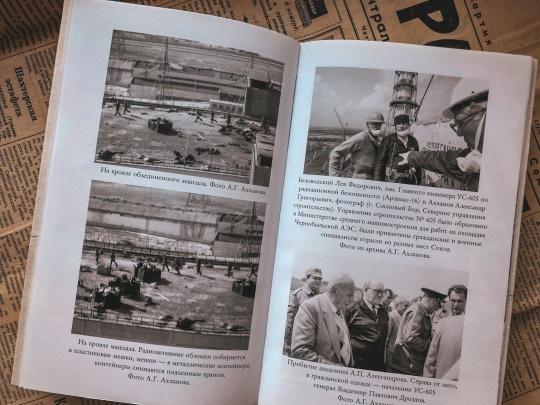
On the roof of the united turbine hall
On the roof of the turbine hall. Radioactive debris is collected in plastic bags, bags are placed in metal containers, containers are removed by a crane
Belovodskiy Lev Feodorovich, deputy of the Chief Engineer of УС-605 on radiological safety (Arzamas-16) and Akhlamov Aleksandr Grigorievich, a photographer ( the city of Sosnoviy Bor, North Construction Department). The Construction Department №605 was formed in the Minsredmash to carry out work on the site of the Chernobyl NPP, civil and military specialists were involved
Arrival of the academician A.P. Alexandrov. On his right, in civilian clothes – the Head of the Construction Department 605, General Vladimir Pavlovich Drozdov

The crew of the MI-8 helicopter. Before flying around the NPP site with Usanov Alexander Nikolaevich, the Deputy Minister of Medium Machine Building
Working on the roof. Packing radioactive waste in plastic bags
Dosimetrists. The base of the ventilation pipe turned out to be one of the most contaminated area. Sandbags along the perimeter are laid as formwork for subsequent pouring with a layer of concrete.
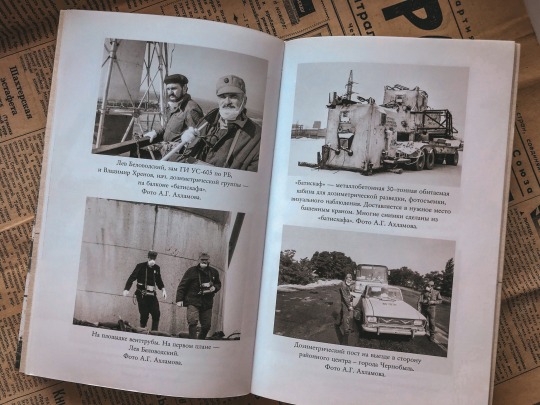
Lev Belovodskiy, deputy of the Chief Engineer of УС-605 on RS and Vladimir Khrenov, Chief of the dosimetric group – on a balcony of the « Bathyscaphe»
On the site of the vent pipe. In the front – Lev Belovodskiy.
«Bathyscaphe» - metal-concrete 30-ton manned cabin for dosimetric survey, photography, visual observation. Delivered to the destination by a tower crane. Many pictures were taken from the bathyscaphe.
Dosimetric monitoring station at the exit towards the regional center - the city of Chernobyl

The group of liquidators on the way from the pioneer camp «Golubie ozera» («Blue Lakes») to the NPP site. Time of getting up – 5 am
Main control room in the building of the reactor auxiliary systems
May 8, 1986. Eve of the Victory Day
Reactor auxiliary systems room. A.K. Efremov reports to the Deputy Minister of Minsredmash A.N. Usmanov

Government Commission after inspection of the cleaned and restored roof of the united turbine hall of the ChNPP Dosimetric control.
@elenatria @alyeen1 @litttlesilkworm @rbmk-ana @the-jewish-marxist @soviet-history-detective @owlboxes @borislegasov
#chernobyl npp#chernobyl disaster#chernobyl#ussr#soviet history#history talk#valery legasov#boris shcherbina#liquidator
58 notes
·
View notes
Text
Our favorite thrillers as newspaper headlines, because why not
*Puts on newsie cap* Thrillers here!!!! Get your thrillers here!!!! Get your heart-pounding, sleep-stealing, can’t-stop-reading thrillers here!!!!
Ya want Cold War espionage? We got it! Ya want serial killers?? How about six??!! Not in the mood for fiction? How ‘bout a TRUE crime story?!
EXTRA! EXTRA! READ ALL ABOUT ‘EM! Excerpts, that is, linked below!
THE INVITED by Jennifer McMahon - VERMONT COUPLE DESIGNS NEW HOME, ACCIDENTALLY BUILDS HAUNTED HOUSE
KILLER’S CHOICE by Louis Begley - “THE MONSTER” IS REAL: UPPER EAST SIDE NOVELIST TARGETED BY SERIAL KILLER
SAY NOTHING by Patrick Radden Keefe - NEW YORKER WRITER DIVES INTO “THE TROUBLES,” SOLVES DECADES OLD MURDER
THE DEVIL ASPECT by Craig Russell - THE “DEVIL’S SIX” SPEAKS: CAN “PSYCHOLOGY” BE THE KEY TO CATCHING A KILLER?
THE PLOTTERS by Un-su Kim - ASSASSINS COMPETE FOR DOMINANCE IN ALTERNATE-UNIVERSE SEOUL; CHAOS ENSUES
BLACK SUN by Owen Matthews - MURDER AT ARZAMAS-16: KGB OFFICER CAUGHT IN NUCLEAR CONSPIRACY
6 notes
·
View notes
Text
Russia reveals new details about deadly missile test
https://news.yahoo.com/russians-killed-missile-test-blast-were-working-weapons-154148120.html
Russia Reveals New Details About Deadly Weapons Test
Published August 12, 2019 | AFP | Posted August 12, 2019 |
Moscow (AFP) - Russia's nuclear agency chief on Monday confirmed that five scientists killed last week were developing "new weapons" and vowed to continue testing despite the explosion.
The accident took place at an Arctic military facility on the coast of the White Sea on Thursday, but Russian authorities only admitted its nuclear nature on Saturday.
The explosion caused a spike in radiation levels.
US experts have said it could be linked to testing of the "Burevestnik" cruise missile, touted by President Vladimir Putin earlier this year.
As a memorial service was held for the scientists on Monday, the head of nuclear agency Rosatom said their efforts would continue.
"The best (thing) for their memory will be our further work on the new weapons," Alexei Likhachev was quoted as saying by Russian news agencies.
"We are fulfilling the task of the motherland, its security will be reliably ensured."
Rosatom said this weekend that its staff were providing engineering and technical support for the "isotope power source" of a missile.
The missile was being tested on a platform at sea when its fuel caught fire and caused an explosion, it said. Several staff were blown into the sea by the blast.
The Russian military announced the death of two "specialists" after the explosion but it is not known if they were among the five scientists whose deaths were announced by Rosatom.
Three other people were injured in the accident, suffering burns, according to the nuclear agency.
The military did not initially say that the accident involved nuclear equipment, stressing that radiation levels were normal afterwards.
But the nearby city of Severodvinsk recorded elevated levels following the accident and panicked residents rushed to buy iodine to counteract radiation.
- 'Real heroes' -
In a state of the nation address earlier this year Putin announced the development of what he called "invincible" missiles, threatening to deploy them against "decision-making centres" in Western countries if there were serious threats against Russia.
Experts have linked the blast to the 9M730 Burevestnik nuclear-powered cruise missile, known by NATO as SSC-X-9 Skyfall.
Putin said in February that tests on the Burevestnik were going successfully.
The accident took place at the Nyonoksa test site on the White Sea, used for testing missiles deployed in nuclear submarines and ships since the Soviet era.
A memorial service for the scientists was held Monday in the closed city of Sarov, 500 kilometres (300 miles) east of Moscow.
Sergei Kiriyenko, the deputy head of Putin's administration and a former nuclear chief, called the victims "real heroes" at the ceremony.
He said that while conducting the tests the scientists took on physical risks "which, unfortunately, however much you prepare, cannot be completely avoided."
During the Cold War, Sarov was a top-secret city known as Arzamas-16. The centre produced the Soviet Union's first nuclear weapons.
It is still a closed city accessible only with special passes.
Last month, 14 Russian navy officers were killed in a fire on a top-secret nuclear-powered submersible in circumstances that have not been fully revealed.
The incident comes with fears of a new arms race after Moscow and Washington withdrew earlier this year from the Cold War-era Intermediate-Range Nuclear Forces (INF) treaty.
#politics#u.s. news#donald trump#trump administration#politics and government#president donald trump#white house#republican politics#trump#us: news#republican party#international news#must reads#national security#world news#impeachthemf#russia#vladimir putin#putin#nuclear weapons#nuclear#defense department#defense#u. s. military#military#u.s. military#pentagon
4 notes
·
View notes
Photo



comrades forgive me for arriving late to the battle...
but it’s better late then never Da ?
Fuze Elite set 2nd shock army (2-я Ударная армия)



inside that bag is what i assume names of hostages he killed...
i mean sekrit dokuments




Weapon skins have 11 slashes in common (well fuze ace requires 11 kills)
enemy team (5) + your team (4) + hostage (1) + announcer (1)
ARZAMAS-17
arzamas-16 was soviet name of small town (sarov in modern times)
it made lovely war hardware such as BM13 katyusha and most importantly it was center of nuclear weaponry and home of world’s strongest bomb the
TSAR BOMBA
in otherwords it’s perfect town to cheeki breeki
the weapons have neat greenish white / red coloring to them and has word СПЕЦНАЗ (SPETSNAZ) written in russian. cosmoline wood texture is just ....blyatiful




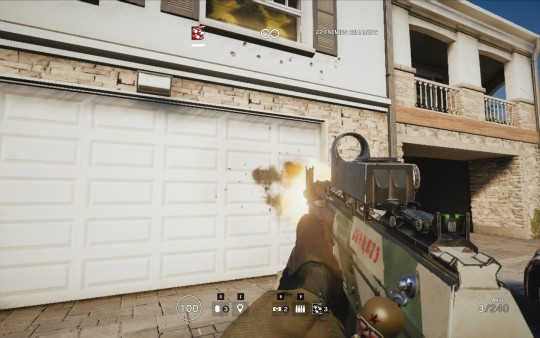





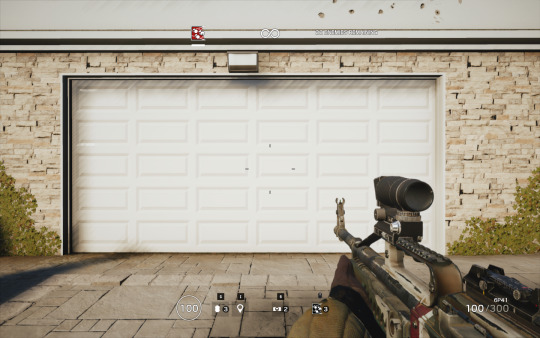


there is a nice touch done for this 6P41 skin

it has nice scribbles of FUZE THE HOSTAGE ! all over it. 10/10
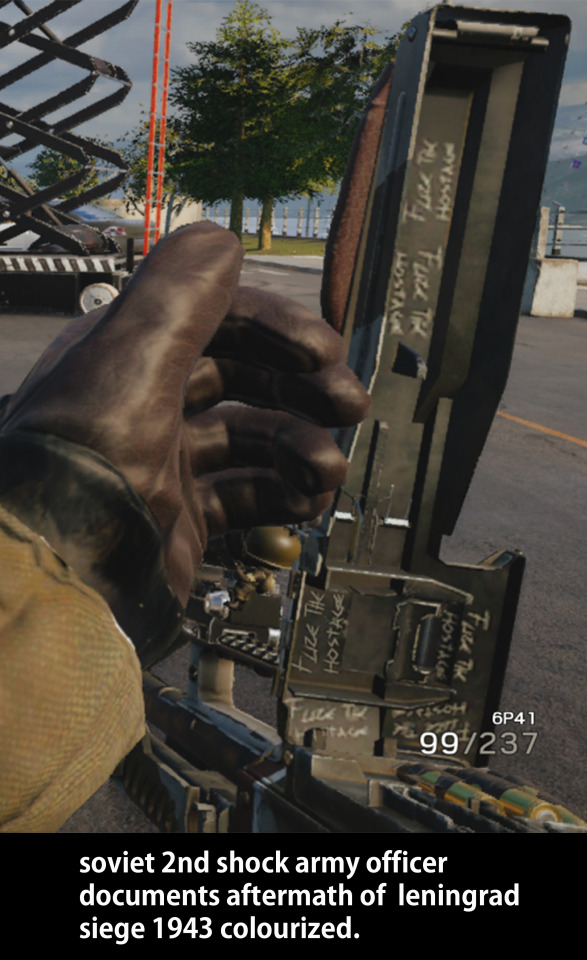
PMM and GSH18 also shares the same skin






ШИСБР - Штурмовая инженерно-сапёрная бригада
(SHISBR - Assault Engineer Sapper Brigade)
shield gets a nice skin named “MOTHER LAND” and it’s a soviet propaganda poster style with a slash number count. honestly i was expecting a large soviet flag on it and maybe some stalinium jokes but hey ... i love soviet propaganda
also STEEL CITADEL skin is perfect fit with all the soviet-era theme so if you are into that you can use that skin for maximum Russian Bias.

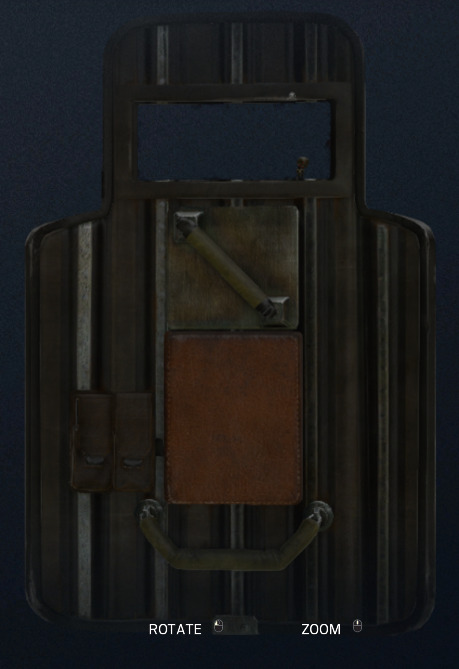

Also you get little fuze to put on any of your weapons or shield giving approval nodding for any operators to blow hostage up

as for your hostage murdering device APM-6 MATRYOSHKA
it’s renamed as URA !
a iconic battle cry of soviet soldiers
it has nice Red soviet star and writing ДЕРЖИТЕСЬ ТАМ! (Hold on!) on it.


And always a nice way to finish your end game screen as a proud soviet soldier
vintage style Propaganda film to spread words of victory.
fuze takes out a pistol (player choice) and will fire at the sky multiple times before he does military stance.
love the effect but sadly no hostage related stuff on it .
youtube
ok.. this skin and whole elite set is just spot on
the weapon skins are neat it’s not reflective it’s done in cold war / ww2 tone and just goes perfectly with the uniform. not to mention all the fuze memes and work put into it .
uniform is just well really old but gold with all the protection and thicc clothing he is wearing just makes you feel warm even in middle of siberia.
and well victory animation is again very vintage nothing out of it’s place and the music is well could been more soviet ... still very good.
Now get your copy of this set and Go blow some more hostages in christmas times. if not well ask Ded moroz on Russian christmas on January 8th he may get you one.
#fuze elite#fuze#fuze rainbow six siege#i am late to the war but it's not finished yet#fuze 2nd shock army#i love this skin#rainbow six siege#best christmas gift i bought for myself#fuze the hostage
72 notes
·
View notes
Text
Hola te invito a leer la decimosexta parte de la ultima parte de la trilogia los pobres no deben amar.
Titulada: Arzamas 16
Link: https://my.w.tt/qSMak74RK9
sinapsis
En la decimosexta parte de esta ultima parte de la trilogia, Edward y Ivana, tienen que dividir su vida entre Argentina y Arzamas 16, para poder estar juntos.
Aislados del mundo en esta ciudad cerrada, Edward, descubre que el lugar no es nada seguro y Ivana corre gran peligro.
Victoria y Manel siguen tratando de conservar su matrimonio, sin imaginarse los enemigos ocultos que poseen.
Stalin se da cuenta que Ivana ha sido posiblemente programada para matar a Eudoxia por la orden oscura y le ordena a Beria para ponerlos en una trampa, que la asesine al terminar la bomba atomica.
Eudoxia irónicamente salva a Helen y a Moises de los gulags, pero no salva a Thomas de morir en manos de la delicuencia organizada en Odessa.
La guerra fria ha comenzado, Inglaterra y Estados Unidos se unen en Alemania creando la bizona para desafiar a Stalin y en Grecia los Estados Unidos sustituye a Inglaterra y empiezan aplicar la doctrina Truman
Inesperadamente los arcontes se empiezan a manifiestar en el plano material, para sorpresa de Stalin y Eudoxia, que ignoran sus intenciones
En este mundo dividido y en transición a un nuevo orden mundial, Eudoxia, trata de conservar su familia y Stalin protegerla de sus enemigos

0 notes
Text
Russia mourns ‘heroes’ killed in missile test
MOSCOW: The city that hosts Russia’s main nuclear research site announced a day of mourning Sunday for five of its staff killed during a missile test that provoked elevated radiation levels.
Russia has said that five nuclear agency workers were killed Thursday by a blast during testing of a nuclear-powered missile at an Arctic facility.
The closed city of Sarov in the Nizhny Novgorod region, about 500 kilometres (300 miles) east of Moscow, declared 24 hours of mourning from 1:00 pm (1000 GMT) Sunday, with flags lowered and entertainment events cancelled, RIA Novosti state news agency reported.
The decree identified the five victims as staff of the Russian Federal Nuclear Centre.
The centre’s chief said that the Rosatom nuclear agency had asked President Vladimir Putin’s administration for those who died to be awarded posthumous medals.
“They are heroes of modern Russia and we will remember them,” chief Valentin Kostyukov said in a video statement posted by Sarov media.
Rosatom said memorial services would be held on Monday.
During the Cold War, Sarov was a top-secret city known as Arzamas-16. The centre produced the Soviet Union’s first nuclear weapons.
It is still a closed city accessible only with special passes.
Rosatom said the accident occurred while a missile was being tested on an offshore platform in the far northern Arkhangelsk region.
Fuel exploded and the blast blew staff into the sea, it said.
Russia’s military initially said two people had been killed in the accident and it was not known whether they were among the five that Rosatom reported.
The nearby city of Severodvinsk recorded elevated radiation levels following the accident and panicked residents rushed to buy iodine to counteract radiation.
Alexander Chernyshov, deputy head of research at the Sarov nuclear centre, said in a video statement Sunday that researchers had checked levels in Severodvinsk and confirmed a brief spike.
“The radiation background level was exceeded twofold and lasted no more than an hour,” he said.
“Neither our experts nor outside experts have recorded any remaining radioactive contamination,” Chernyshov added.
Professor Jeffrey Lewis of the Middlebury Institute of International Studies said his “working hypothesis” was that the blast was related to the 9M730 Burevestnik nuclear-powered cruise missile, known by NATO as SSC-X-9 Skyfall.
In February, Putin said that tests on the Burevestnik were going successfully.
A state commission is investigating the accident.
The post Russia mourns ‘heroes’ killed in missile test appeared first on ARYNEWS.
https://ift.tt/2FKHQyb
0 notes
Text






Mama moose with her baby wandered into a city park. It wasn't unheard of in the 70s-80s. Arzamas-16 (Sarov), Russia.
156 notes
·
View notes
Text
2019-20 Torpedo Nizhny Novgorod Roster
Wingers
#12 Anton Shenfeld (Magnitogorsk, Russia)
#16 Quinton Howden (Oakbank, Manitoba)
#18 Mikhail Varnakov (Nizhny Novogorod, Russia)
#27 Sergei Goncharyuk (Nizhny Novgorod, Russia)
#33 Viktor Shakhvorostov (Kazan, Russia)
#66 Pavel Varfolomeyev (Magnitogorsk, Russia)
#71 Stanislav Bocharov (Khabarovsk, Russia)
#83 Kirill Urakov (Izhevsk, Russia)
#88 Damir Zhafyarov (Moscow, Russia)
#95 Denis Povichalov (Nizhny Novgorod, Russia)
#98 Danil Veryayev (Arzamas, Russia)
Centers
#10 Jordan Schroeder (Prior Lake, Minnesota)
#21 Paul Szczechura (Brantford, Ontario)
#58 Daniil Ilyin (Penza, Russia)
#93 Andrei Belevich (Grodno, Belarus)
Defensemen
#2 Sergei Zborovsky (Moscow, Russia)
#3 Kirill Melyakov (Yaroslavl, Russia)
#5 Charles Genoway (Morden, Manitoba)
#8 Denis Barantsev (Tolyatti, Russia)
#24 Anton Volchenkov (Moscow, Russia)
#45 Artyom Alyayev (Nizhny Novgorod, Russia)
#51 Maxim Mineyev (Omsk, Russia)
#74 Mikhail Orlov (Moscow, Russia)
#85 Georgi Misharin (Sverdlovsk, Russia)
Goalies
#39 Anders Lindback (Gavle, Sweden)
#90 Andrei Tikhomirov (Nizhny Novgorod, Russia)
0 notes
Link
MOSCOW: The city that hosts Russia’s main nuclear research site announced a day of mourning Sunday for five of its staff killed during a missile test that provoked elevated radiation levels.
Russia has said that five nuclear agency workers were killed Thursday by a blast during testing of a nuclear-powered missile at an Arctic facility.
The closed city of Sarov in the Nizhny Novgorod region, about 500 kilometres (300 miles) east of Moscow, declared 24 hours of mourning from 1:00 pm (1000 GMT) Sunday, with flags lowered and entertainment events cancelled, RIA Novosti state news agency reported.
The decree identified the five victims as staff of the Russian Federal Nuclear Centre.
The centre’s chief said that the Rosatom nuclear agency had asked President Vladimir Putin’s administration for those who died to be awarded posthumous medals.
“They are heroes of modern Russia and we will remember them,” chief Valentin Kostyukov said in a video statement posted by Sarov media.
Rosatom said memorial services would be held on Monday.
During the Cold War, Sarov was a top-secret city known as Arzamas-16. The centre produced the Soviet Union’s first nuclear weapons.
It is still a closed city accessible only with special passes.
Rosatom said the accident occurred while a missile was being tested on an offshore platform in the far northern Arkhangelsk region.
Fuel exploded and the blast blew staff into the sea, it said.
Russia’s military initially said two people had been killed in the accident and it was not known whether they were among the five that Rosatom reported.
The nearby city of Severodvinsk recorded elevated radiation levels following the accident and panicked residents rushed to buy iodine to counteract radiation.
Alexander Chernyshov, deputy head of research at the Sarov nuclear centre, said in a video statement Sunday that researchers had checked levels in Severodvinsk and confirmed a brief spike.
“The radiation background level was exceeded twofold and lasted no more than an hour,” he said.
“Neither our experts nor outside experts have recorded any remaining radioactive contamination,” Chernyshov added.
Professor Jeffrey Lewis of the Middlebury Institute of International Studies said his “working hypothesis” was that the blast was related to the 9M730 Burevestnik nuclear-powered cruise missile, known by NATO as SSC-X-9 Skyfall.
In February, Putin said that tests on the Burevestnik were going successfully.
A state commission is investigating the accident.
The post Russia mourns ‘heroes’ killed in missile test appeared first on ARYNEWS.
https://ift.tt/2YVFXJH
0 notes
Text
Arrests Making Headlines Across the Globe
Gone are the days when shady dealings in crypto were perceived as immune to the clutches of law enforcement.
Illicit crypto proceeds can be shuttled between wallet addresses at the click of a mouse, and their obfuscation behind the multiple strings of numbers and letters of wallet addresses can create a dizzying — if not impenetrable — cryptographic maze for authorities to navigate.
But the criminals themselves present a more concrete target, and as they interface with everything from crafty code to unwieldy hardware to ‘traditional’ firearms, there has been some success in 2018 in nabbing some of the year’s darkest — and most imaginative — offenders.
From soap actors to former lawmakers, Cointelegraph takes stock of some of the most illustrious arrests of the figures behind crypto’s high crimes and misdemeanours this year.
Foiled supercomputer Bitcoin heist in Russian nuclear no-man’s land
In February, Russian security agents scored a coup against a group of nuclear engineers at a top-secret nuclear warhead facility who tried to use one of the country’s most powerful supercomputers to mine Bitcoin (BTC).
The engineers worked at the Federal Nuclear Center in the western city of Sarov — formerly one of the Soviet Union’s closed-off cities, unmarked on historic maps and shrouded in secrecy.
As one of the Soviet “closed administrative territorial entities,” Sarov was then known as Arzamas-16, and was the center of research and production for the first Soviet atomic bomb and hydrogen bomb under Joseph Stalin. Special permits are still required today for ordinary Russians to visit it.
With such a stellar off-grid history, you’d think the Bitcoin-hungry nuclear engineers might have suspected that connecting the site’s supercomputer — a 1 petaflop titan with a capacity for 1,000 trillion calculations per second — to the internet might draw just a little attention.
As soon as the engineers tried to bring it online, the security department was alerted and was able to foil the scientists, who were peremptorily handed over to the Federal Security Service (FSB).
Tatiana Zalesskaya, the head of the press service for the research institute, told the Interfax news agency that that the attempt was a “technically hopeless and criminally punishable offense.”
A criminal case was reportedly duly opened against them.
Contentiously, it has been alleged that the radioactive polonium-210 used to kill ex-FSB agent Alexander Litvinenko in London in 2006 was produced in Sarov, which houses a plant that is said to be the “world’s only commercial producer of the substance,” according to evidence presented before a court in the United Kingdom.
Sarov’s rogue scientists are not the only ones to have thought of using former Soviet military spaces for crypto mining. The Ice Rock Mining firm has plans to — legally — set up mining operations in a former Soviet bunker located in a cave in Almaty, Kazakhstan.
Caught in the headlights: Thai actor “Boom” arrested on set for alleged crypto fraud family affair
This summer, reports emerged tied to the story of a Finnish millionaire allegedly fooled by a Thai crypto investment scam — to the tune of Bitcoin worth 797 million baht ($24.62 million) at the time.
According to the Thai Crime Suppression Division (CSD), the 22-year-old Finn, identified as Aarni Otava Saarimaa, claimed he had been lured into investing his Bitcoin into several companies, a casino and the gambling-focused crypto token Dragon Coin.
Saarima’s business partner, the Thai businessman Chonnikan Kaeosali, reportedly first approached the CSD in January this year, outlining how the pair had been drawn to purchase shares in three firms — Expay Group, NX Chain Inc. and DNA 2002 Plc — that were purported to be investors in Dragon Coin. He said they had first been approached in connection with the affair by a local Thai group back in June 2017.
The fraudsters are said to have taken their would-be victims around a Macau-based casino where they claimed the gambling-focused token would soon be used. Saarima subsequently transferred his crypto but never saw returns, shareholder papers nor any proof of investment in Dragon Coin.
As the CSD’s investigations unfolded, they identified a group of nine suspects — three of whom were revealed to be a group of siblings from the Jaravijit family. The suspects are said to have swiftly sold the crypto for local fiat currency, dispersing the spoils between various bank accounts.
It was the arrest of one of the siblings this summer — a dapper 27-year-old soap-opera star known as Jiratpisit “Boom” Jaravijit — that first brought the case to public light.
On Aug. 9, Boom was taken into custody on money laundering charges in the midst of filming at the Major Cineplex Ratchayothin in Bangkok’s Chatuchak district. Local media noted it was the day after the star’s birthday.
It was alleged that the actor had colluded with his siblings to launder the swindled money, after investigations revealed they had bought 14 plots of land worth 176 million baht ($5.44 million).
Boom’s brother, Prinya Jaravijit, is said to have been the ringleader of the scheme, having reportedly received a tip-off from a Thai banker about the wealthy Finn and then setting the heist in motion. Prinya has reportedly fled to South Korea, while Boom’s sister is said to have made contact with the CSD to turn herself in.
The CSD has sought arrest warrants for a further six suspects and frozen a total of 51 different bank accounts in addition to the siblings’ land.
Boom was temporarily released on a 2 million baht ($61,827) bail bond on the condition that he would not leave the country, having argued that his arrest on set in a public place was ample proof he had not been intending to flee.
Earlier this month, another Jaravijit sibling turned himself in to deny the fraud charges, while police met two further suspects: Prasit Srisuwan, a well-known stock trader, and Chakris Ahmad.
Boom’s parents, Mr. Suwit and Ms. Lertchatkamol, have also been questioned after police traced that 90 million baht ($2.78 million) had been transferred to their accounts. Both have denied involvement.
India: Former ruling party lawmaker nabbed “fast asleep” on a construction site
As news of the many-tentacled Bitconnect investment heist continues to unfold globally, recent developments have unearthed a web of kidnappings and extortions allegedly tied to Bitconnect investors in the wealthy state of Gujarat.
Earlier this month, a former Member of the Legislative Assembly (MLA) for India’s ruling Bharatiya Janata Party (BJP) was remanded in custody for allegedly conspiring with local police to kidnap and extort Bitcoin from a Gujarati Bitconnect investor.
In February, a Surat-based builder by the name of Shailesh Bhatt had charged into the Home Minister’s office in the Indian state of Gujarat, alleging that 10 district cops had kidnapped and extorted him for 176 BTC, worth 9.45 crore* rupee (around $1.31 million).
*A crore rupee denotes 10 million and is equal to 100 lakh rupee in the Indian numbering system (1 lakh rupee denotes 100,000)
The band of 10 was alleged to have comprised not only rank-and-file constables but even a superintendent and a local Crime Branch Inspector.
Bhatt, who is said to have been known for his penchant for Bitcoin trading, claimed he had been duped by one of his business aides, Kirit Paladiya, into thinking that the authorities were keeping him under close watch for his crypto dealings.
He alleged he had been lured by a phone call from his local Central Bureau of Investigation (CBI), where he was allegedly beaten in a “torture room” and asked by a CBI official to pay a cash ransom.
Two days later, he claimed he was kidnapped during a meeting with his aide Paladiya near a fuel station, where he was whisked off to a local farm house. There, he said, “[the police officers] beat me up inside a room and threatened to kill me […] if I did not hand over my Bitcoins.”
Bhatt then accused Paladiya of double-crossing him in cahoots with his influential uncle, the former BJP MLA Nalin Kotadiya, who he claimed had been the one who pressured him into paying the ransom.
Bhatt has himself been subsequently accused of being a wolf in sheep’s clothing. He has become embroiled in a case pertaining to an alleged earlier extortion of a staggering 1.55 billion rupee ($215 million) worth of crypto and cash at gunpoint — including around 2,400 BTC — from two colleagues of well-known local Bitconnect promoter Satish Kumbhani.
However, Indian authorities nonetheless believed there is some weight behind the accusations against the former lawmaker Kotadiya, first issuing an arrest warrant against him in mid-May.
Kotadiya has repeatedly hit back against the allegations, notably via a WhatsApp video — reposted on Youtube in late April — in which, attired in pink, he claimed he had duly informed authorities about the Bitcoin heist and attributed the full blame for the extortion scandal and conspiracy to Bhatt.
Moreover, he threatened to leak evidence that would implicate even more local politicians in the scandal, saying that Bhatt was protecting them and therefore attempting to “fix him” in the case.
Nonetheless, by mid-June, a local sessions judge declared Kotadiya a “proclaimed offender” (absconder) and demanded he appear before the court within 30 days.
As Kotadiya continued to elude the clutches of law enforcement throughout summer, he was finally nabbed after four months in hiding on Sept. 10. He was reportedly found “fast asleep” on the second floor of a railway quarters still under construction, after a local contractor gave police the golden tip-off.
“When we [eventually] found him, he was sleeping on a mattress and there was just an earthen pot of water in the room.”
As Cointelegraph has reported, Kotadiya’s alleged embroilment has been a political gold mine for the opposition party, the Indian National Congress (INC), who allege that further members of the ruling BJP have used the Bitconnect scam to launder undeclared “black” money.
“The finger of suspicion of this massive scam of illegal cryptocurrency directly points to several top Bharatiya Janata Party leaders and a mastermind — an absconding BJP leader and former MLA Nalin Kotadiya […] Who are the top BJP leaders against whom Kotadiya has damning evidence? We demand an impartial Supreme Court-monitored judicial investigation.”
As of press time, the time of Kotadiya’s custody is up, yet the alleged evidence he claims to wield is yet to have been made public.
Iceland’s Bitcoin miner heist: A high-gliding fugitive and suspect hardware in Tianjin
This year, what has been described as one of Iceland’s “largest criminal cases in history” has seen an outlandish set of twists and turns, leading all the way to the northern Chinese city of Tianjin.
In February, news broke of a series of unprecedented thefts, involving powerful computing equipment that had been stolen in a “highly organized” Bitcoin mining heist. Three burglaries were reported to have taken place in December 2017 and a fourth in January.
The burglars had allegedly swiped 20 million krónur (around $180,000) worth of equipment — 600 graphics cards, 100 power supplies, 100 motherboards, 100 memory discs and 100 CPU processors — from a house in the municipality of Reykjanesbær.
They had also allegedly broken into data centers across both Reykjanesbær and Borgarbyggð, with a total of 600 computers stolen from both places, worth 200 million krónur (almost $2 million). The whereabouts of the equipment, including the computers — said to have been used for Bitcoin mining — remained untraceable, even as authorities monitored energy consumption for suspicious increases.
Police are said to have initially arrested eleven suspects — two of which were ordered to remain in custody, after the Icelandic IT firm Advania produced incriminating surveillance footage taken at the data center in Reykjanesbær. The authorities soon recovered most of the stolen equipment, yet the 600 computers remained elusive. Both suspects were reported in local media as being “uncooperative.”
Then, on April 17, one of the detainees escaped at 1 a.m. from his custody in an “open” (low-security) prison, just a week before authorities were due to move forward with an indictment.
The fugitive, Sindri Thor Stefánsson, fled the country on a passport bearing another man’s name, boarding a passenger plane to Sweden that was embarrassingly revealed to have been carrying Iceland’s prime minister.
Stefánsson subsequently released a statement claiming he had been “legally allowed” to travel on the day he boarded the plane to Stockholm, as his custody ruling expired April 16 and a judge had requested 24 hours to consider its renewal. This, according, to him, left a brief interim during which the warrant for his custody was legally invalid.
He vowed to return home “soon,” telling reporters he would be challenging his two-and-a-half-month custody at the European Court of Human Rights.
Days later, he was arrested in central Amsterdam, after a photo published on Instagram with the hashtag #teamsindri allegedly gave him away, according to media outlet Iceland Monitor. Police at the time did not confirm this was the case.
Allegedly incriminating Instagram snap of Stefánsson in Amsterdam: Source: Iceland Monitor
Despite #teamsindri reportedly briefly trending across Icelandic Twitter, the case last month came to a head when a judge charged Stefánsson — alongside six others — with the theft of the 600 computers. While Stefánsson’s charge has been confirmed as theft, it remains unclear what role the other six defendants are charged with as having in the incident.
Just days after Stefansson’s Amsterdam stint, police in the northern Chinese city of Tianjin seized 600 computers used to mine Bitcoin, after abnormal electricity usage attracted the attention of the local power grid operator. Local media outlets reported the case as being the “largest power theft case in recent years,” but it notably also drew the attention of authorities back in Iceland, who suspected the exact number match of suspect hardware was more than just an uncanny coincidence.
Icelandic police subsequently reached out to Chinese authorities to try to link the two cases, yet no results have been reported since then.
“One of the best out there”: A teenage SIM-swapping crypto hacker with a taste for luxury cars
Last month, Californian police nabbed a hacker who allegedly stole Bitcoin worth over $1 million via a series of so-called ‘SIM-swapping’ heists — also known as ‘port-out scams.’ The 19-year-old suspect, identified as Xzavyer Narvaez, is said to have specialized in stealing cell phone numbers and using them to hijack online financial and social media accounts tied to those numbers.
A SIM-swap attack results in the victim suddenly losing all service, with any incoming calls or text messages redirected to the attacker’s device. As many firms use automated messages or phone calls to handle customer authentication, SIM swaps can be a goldmine in deft hands.
Prosecutors allege that Narvaez used his ill-gotten crypto proceeds to purchase luxury goods, including a $200,000 high-performance McLaren sport car, which were tracked through records obtained from Bitcoin payment provider BitPay.
According to cybercrime blog Krebs on Security, the investigators interviewed several alleged victims of Narvaez, one of whom claimed he was robbed of $150,000 in crypto after his SIM was hijacked.
Between March and June 2018 alone, Narvaez’s account on crypto exchange Bittrex reportedly saw a flow of a staggering 157 BTC. He subsequently faced charges on four counts of using personal identifying information without authorization; four counts of altering and damaging computer data with intent to defraud or obtain money, or other value; and grand theft of personal property of a value over $950,000, according to court documents.
VICE’s parallel investigations traced Narvaez’s impressive “credentials” in the SIM-swapping underworld, with one source telling the magazine that he was considered “one of the best […] out there.” VICE’s source provided screenshots of Narvaez’s former Instagram account, which allegedly featured euphoric photos of his fresh, 2018 snow white McLaren, accompanied by the caption “live fast, die young.”
Narvaez is said to have come under the radar of law enforcement following the arrest of one Joel Ortiz, described as “a gifted 20-year-old college student from Boston” who was charged this July with using SIM swaps to swipe over $5 million in crypto from 40 different victims.
A redacted “statement of facts” in the case obtained by Krebs revealed that records obtained from Google had traced that a cellular device used by Ortiz to commit SIM swaps had at one point been used to access the Google account identified as [email protected].
In an unrelated case this July, Florida police reportedly arrested a 25-year-old, Ricky Joseph Handschumacher, who was accused of being part of a multi-state, cyber-fraud SIM-swapping ring that operated over the course of two years.
The gang of nine — scattered across different states — was initially tracked in February, when a “worried mom” overheard her son talking on the phone impersonating a telecoms firm employee. The group is alleged to have “routinely paid” employees at cell phone companies to assist in their schemes and to even have discussed a plan to hack accounts belonging to the CEO of the high-profile Gemini Trust company — namely those of Bitcoin billionaire Tyler Winklevoss.
Handschumacher himself posted multiple flashy purchases — including a pickup truck, multiple all-terrain vehicles and jet skis — on his public Facebook profile. Subpoenas to Coinbase revealed he had sold 82 BTC through his account, “virtually all” of which were not purchased on the platform.
As law enforcement closed in on this host of spry and unabashed millennial SIM swappers, in August, a U.S. investor filed a $224 million lawsuit, taking on telecoms giant AT&T. Michael Terpin accused the firm of alleged negligence, claiming that $24 million in crypto was stolen via a “digital identity theft” of his cell phone account.
His complaint alleged that:
“What AT&T did was like a hotel giving a thief with a fake ID a room key and a key to the room safe to steal jewelry in the safe from the rightful owner.”
“Fake news”: OKEx CEO “detained” for alleged fraud
The most recent high-profile, crypto-related “detention” involves OKEx CEO Star Xu, who was the subject of a host of conflicting media reports — and even one viral dumpling-related anecdote — following his sudden tête-à-tête with Chinese authorities this month.
Xu has robustly hit back at rumors that fraud was the reason for his purported ‘arrest,’ after local media reported that he had faced problems at his hotel from a group of investors in WFEE Coin, a blockchain WiFi sharing project they claimed Xu held shares in.
The allegedly defrauded victims had reportedly contacted Shanghai police, who “summoned” the CEO to a police station on Sept. 10 to “put [him] through a round of questioning to get to the bottom of the rumors,” as tech news source ZeroHedge wrote at the time.
A photograph of a police report about Xu on local news outlet Sina Technology appeared to confirm that the police had been notified at 5:59 p.m. on Sept. 10.
Image of police report allegedly involving Star Xu’s detention. Source: Sina Technology
At the same time, alternative sources in China claimed the investors were in fact traders incensed by system failures on the OKEx exchange itself. As Bitcoin (BTC) tumbled on Sept. 5, OKEx platform crashes are alleged to have left users unable to close or otherwise salvage their positions, with losses all the more acute in the case of leveraged trades.
Cointelegraph’s own Chinese sources have since thrown some degree of light on what had spiralled into a sordid media affair, substantiating suspicions that much of the hearsay was indeed “fake news.”
The sources have emphasized that Xu was the one who approached the police of his own accord. In their account, on Sept. 10, Xu had arrived at the Shanghai office of OK Group to meet with customers and conduct other business affairs. He had also — incidentally — made an appointment at the office to meet with a prospective personal fitness coach.
There, the first troubles with the disgruntled investors are said to have begun — who are thought to have been a mix of OKCoin and WFEE Coin investors. Some ambiguity remains as to their exact identity — and whether they were indeed railing against problems tied to the OKEx exchange or held Xu responsible for the vicissitudes of the WFEE token, or a mix of both.
Having gotten wind of Xu’s visit to Shanghai, the aggrieved group is alleged to have been responsible for vandalizing the sign at the city’s OK Group office, as appears to be shown in the following photograph:
Photo showing the apparent vandalization of OK Group’s entrance sign at the Shanghai office
An alarmed Xu is said to have headed back to his hotel, telling his prospective coach to make her way there as well, so as to resume their meeting. The investors are alleged to have then followed the woman’s tracks, suspecting she would lead them to Xu. There, they are alleged to have knocked on the door of the CEO’s room, threatening him.
After four tense hours, Xu is said to have alerted the police. The investors are again alleged to have followed his trail, whereupon Xu called a group of “henchmen” to join him at the police station. At this point, the investors are said to have taken fright and approached the authorities themselves.
In an interview published soon after his release, Xu confirmed he had been held by Shanghai police, seeming to imply he had made the contact on his own initiative:
“In Shanghai, someone reported that I was defrauding. I went to the police station to explain the situation and proved to the police that I did not swindle.”
On Twitter, OKEx COO Cheung also stated that Xu had been encircled by a group in Shanghai, although in his account, the police are said to have arrived to the scene themselves and moved all parties involved to the station. Cheung alleged that:
“While Star was invited to help with the investigation and those people was detained, they raised a fraud complaint against Star. Star stayed to clarify and then left afterward.”
According to Cointelegraph’s sources, no one was witness to Xu’s departure from the station, and it remains unclear how long he spent there.
Xu has stated that while it is “normal” for citizens to exercise their right to make such allegations, he has equally fulfilled his “duty” as a citizen by cooperating with the authorities. In terms of his alleged responsibility for system “abnormalities” on the exchange, Xu has responded that:
“I am not a legal person of OKEx, nor am I a shareholder or a director.”
This point was echoed in Cheung’s parallel tweets, in which the COO stressed that “Star is the founder of OK Group, [and] although we are good friends, he does not run OKEx.” Cheung has added that he felt “disappointed that the story was twisted before the truth came out.”
Local news outlet Jiemian has meanwhile reported that seven out of a total of 300 investors who claimed to have “suffered heavy losses” on the OKEx exchange have since reached a form of settlement with Xu. Notably, repeated system failures are alleged to have caused a total economic loss of “around 300 million yuan.”
In his post-release interview, Xu stressed that while leveraged trading is a “neutral tool in itself,” it is “not suitable for ordinary investors” as the potential for accelerated net profits and losses requires “professional knowledge” to manage the risks involved.
As Jiemian noted, while OKEx offers investors the opportunity to add as much as 20 times leverage to their contracts, unlike traditional futures trading platforms, the exchange operates without regulatory oversight.
As for the WFEE connection, OK Blockchain Capital (OKBC) — a strategic partner of OKEx and a subsidiary of OK Group — has publicly refuted the allegations that Xu had any shares in the project, tweeting on Sept. 12 that:
“The rumor that OK Group founder Star Xu [is] a shareholder of WFEE is fake. Mr. Xu has no equity relationship with WFEE and its company.”
OKBC has further clarified its own relationship with WFEE, stating that “OKBC is one of the institutional investors of WFEE.” WFEE reportedly “acquired OKBC’s and several other capitals’ investments […] when it was still the prime partner of WeShare WiFi — a global leading WiFi sharing company.” The firm added that it had not been notified of subsequent changes to the WFEE white paper, as OKBC “neither participates in” WFEE’s operations, nor in its “results.”
OKBC has also pointed to the fact that OKEx had warned its users of the potential risks posed by WFEE in August and included WFEE in their first “Token Delisting/Hiding Guideline [sic].”
So… what of the dumplings?
Amid the flurry of “twisted” media reports, one viral anecdote alleged that the band of investors had brought a hungry — and short-of-cash — Xu some sustenance, namely dumplings, as he underwent questioning at the police station. The story, despite its oddity, appears to have had some traction. Cointelegraph’s Chinese sources, for their part, dismissed it out-of-hand as an unthinkable and breathless piece of confected hearsay.
window.fbAsyncInit = function() { FB.init({ appId : '1922752334671725', xfbml : true, version : 'v2.9' }); FB.AppEvents.logPageView(); };
(function(d, s, id){ var js, fjs = d.getElementsByTagName(s)[0]; if (d.getElementById(id)) {return;} js = d.createElement(s); js.id = id; js.src = "http://connect.facebook.net/en_US/sdk.js"; fjs.parentNode.insertBefore(js, fjs); }(document, 'script', 'facebook-jssdk'));
!function(f,b,e,v,n,t,s) {if(f.fbq)return;n=f.fbq=function(){n.callMethod? n.callMethod.apply(n,arguments):n.queue.push(arguments)}; if(!f._fbq)f._fbq=n;n.push=n;n.loaded=!0;n.version='2.0'; n.queue=[];t=b.createElement(e);t.async=!0; t.src=v;s=b.getElementsByTagName(e)[0]; s.parentNode.insertBefore(t,s)}(window,document,'script', 'https://connect.facebook.net/en_US/fbevents.js'); fbq('init', '1922752334671725'); fbq('track', 'PageView');
This news post is collected from Cointelegraph
Recommended Read
Editors' Picks
BinBot Pro – Safest & Highly Recommended Binary Options Auto Trading Robot
Do you live in a country like USA or Canada where using automated trading systems is a problem? If you do then now we ...
User rating:
9.5
Demo & Pro Version Get It Now Hurry!
Read full review
Most Popular 2
Bit Bubble Tech – Learn How To Profit Big When Bitcoin Bubble Bursts?
If you have not already heard of the Bit Bubble Tech App, you undoubtedly wish to read this Bit Bubble Tech Review. We ...
User rating:
9.3
Free For 90 Days Get It Now
Read full review
The post Arrests Making Headlines Across the Globe appeared first on Review: Legit or Scam?.
Read more from → https://legit-scam.review/arrests-making-headlines-across-the-globe-12
0 notes
Text
Oleg Taktarov's Greatest Hits UFC News
View this post on Instagram A post shared by Oleg Taktarov Олег Тактаров (@olegtaktarov_official) on Jul 31, 2017 at 2:57am PDT Before there was Khabib, before there was Fedor, before there was any talk of a UFC event in Russia, there was Oleg Taktarov.Calm, cool, and collected, Russia’s Taktarov wasn’t one to engage in any trash talk, but if you were courageous enough to step into the Octagon or ring with him, he would do whatever it took within the rules to get the victory.A native of Siberia’s Arzamas-16 (now known as Sarov) who move … Read the Full Article Here
from UFC News http://www.ufc.com/news/Oleg-Taktarovs-Greatest-Hits
Oleg Taktarov's Greatest Hits UFC News published first on http://thrandythefabulous.tumblr.com
0 notes
Text
[ 19 САЙТОВ, КОТОРЫЕ ПОМОГУТ НАПИСАТЬ СВОЮ КНИГУ ]
Если вы давно мечтали написать книгу, действуйте. Как сказала Барбара Шер, мечты кажутся невозможными, пока не исполнятся. Давайте пройдемся по ресурсам, которые могут пригодиться начинающему (и не только) писателю. Все, что может быть полезным, — в этой подборке.
► 1. Daily Page
(dailypage.co)
Девиз этого сервиса: «Пишите каждый день!» Это тренажер писательских навыков и краткий курс психологической помощи в одном флаконе, потому что отчасти это техника фрирайтинга (правда, привязанная к определенной теме, но выплыть все равно может много интересного — увидите сами). Каждый день на почту вам будет приходить новая тема для мини-сочинения: «Она была так смущена тем, что…», «Чего вы избегаете?», «Одно из самых лучших решений в вашей жизни…», «Что для вас значит искусство?». Писать можно как «в стол», никому не показывая, так и публиковать свои рассказы.
► 2. Раздел «Книгоиздание» на the Question
(thequestion.ru/topic/562/knigoizdanie?sactive=false)
На the Question по теме книгоиздания можно найти много интересных вопросов, которые будут интересны человеку, планирующему написать книгу, и ответов от экспертов. Например, как книги становятся популярными, если их пишет новичок, какой жанр сейчас самый-самый или как издаться самому.
► 3. Сеть словесных ассоциаций
(wordassociations.net/ru)
Этот сервис подбирает ассоциации, возникающие у человека с определённым словом. Для удобства использования каждое из вариантов сопровождается статьями из «Большого толкового словаря русского языка». В основе сервиса заложен программный модуль, анализирующий все известные классические и современные произведения русской и зарубежной литературы, так что у него есть с чем сравнивать.
► 4. Пиши.про
(pishi.pro)
Портал для писателей, объединяющий людей, увлеченных литературой, тех, кому ��нтересно книгоиздание и писательство. Можно даже бесплатно (и удаленно) пройти школу писателя.
► 5. Evernote
(evernote.com)
Муза может застать вас где угодно. Evernote можно установить на ноутбук и смартфон и записывать идеи сразу, как только они пришли вам в голову. Заметки синхронизируются и появляются на всех ваших устройствах. Так вы точно не забудете реплики героев и крутые повороты сюжета. И сможете творить где угодно — хоть в очереди в поликлинике, хоть в за обедом в кафе.
► 6. Арзамас
(arzamas.academy/courses)
Обойти вниманием просветительский проект Arzamas просто невозможно. Десятки бесплатных курсов, подготовленных экспертами — кандидатами и докторами наук, философами, литературоведами и историками литературы. Если вы собираетесь написать исторический роман или хотите серьезно погрузиться в литературу, выбирайте курс и вперед — смотреть видеолекции, читать статьи, интеревью и очерки, подготовленные учеными.
► 7. Мастерская писателей
(writercenter.ru)
Клуб по интересам для писателей, где можно делиться своими произведениями, спрашивать совета у ��олее опытных товарищей, общаться с читателями и критиками, участвовать в конкурсах и литературных играх.
► 8. Грамота.ру
(gramota.ru)
Если возникают сомнение, как пишется то или иное слово, где поставить запятую или можно ли так выразиться, как того требует душа, зайдите на портал Грамота.ру: ответ найдется — в словарях или справочной службе, куда можно написать через специальную форму или даже позвонить (и вам ответят сотрудники Института русского языка имени В.В. Виноградова, представляете?).
► 9. Орфограммка
(orfogrammka.ru)
Коварные запятые и тире так и норовят убежать, а мягкий знак то и дело появляется в неположенном месте? Ничего страшного. Этот сервис поможет обнаружить грамматические, пунктуационные и даже стилистические ошибки в тексте.
► 10. Типограф
(artlebedev.ru/typograf)
Сервис студии Артемия Лебедева, который правильно оформляет текст: ставит нормальные кавычки («елочки» и «лапки»), меняет ошибочно поставленные дефисы на тире, убирает ненужные пробелы.
► 11. Smart Progress
(smartprogress.do)
Новый день — новые свершения. Сервис для достижения целей помогает сформулировать цель (хотя у вас она уже есть — написать книгу), составить план «достигатора», получать полезные советы и даже вдохновляться начинаниями окружающих.
► 12. Словарь синонимов
(synonymonline.ru)
Иногда нужное слово просто не лезет в голову. В таких случаях выручает полезный словарь синонимов, насчитывающий около 220 тысяч синонимических рядов. В него включены как все известные изданные словари, так и новые слова, появившиеся в русском языке за последнее десятилетие, среди которых «гугл», «твитнуть», «окей» и другие.
► 13. Курсы по литературе
(universarium.org/catalog?category=21)
На Универсариуме можно выбрать и прослушать полезные курсы, состоящие из цикла лекций. Например, пройти курс «Сам себе писатель» от московского литературного института им. Горького, одного из самых престижных литинститутов страны.
► 14. Лекции по литературе на Лекториуме
(lektorium.tv/medialibrary?search_api_views_fulltext=..)
Еще один ресурс с лекциями по теме литературы. Вы сможете узнать историю русской поэзии и зарубежной литературы, искусстве прозы, о психологии гениев, языке и литературных канонах, как писать научно-популярные книги и даже посмотреть творческие встречи с Евгением Евтушенко и Андреем Вознесенским.
► 15. Премия «Дебют»
(pokolenie-debut.ru)
Сайт независимой премии «Дебют», куда можно отправить свою рукопись в пяти номинациях: крупная проза, малая проза, драматургия, поэзия, эссеистика. Главный приз — миллион рублей и признание
► 16. Галина Юзефович на Медузе
(meduza.io/specials/books)
Литературный критик, филолог и книжный обозреватель Галина Юзефович написала десятки увлекательных, ярких и порой разгромных рецензий, которые еженедельно выходят на Медузе. Вообще о литературе Юзефович пишет уже двадцать лет, поэтому любому, кто хочет связать свою жизнь с писательством, стоит с ними познакомиться.
► 17. Открытые уроки для писателей
(school-of-inspiration.ru/category/uroki-dlja-pisatelej)
Короткие бесплатные уроки от «Школы вдохновения» по разным темам: три качества писателя, типы речи, продвижение рукописи, писательские кейсы, враги продуктивности, как создается повесть и многое другое.
► 18. Главред
(glvrd.ru)
Сервис для улучшения текста от Максима Ильяхова – преподавателя и разработчика информационного стиля. На сайте вы можете оформить написанное в едином стиле, найти языковой мусор, стоп-слова, штампы и неправильный синтаксис. Для художественной прозы или стихов сервис не годится, но для написания рекламных постов, статей и инструкций подходит идеально.
► 19. Раздел «Литература» на the Question
(thequestion.ru/topic/53/literatura)
Начитанный человек «выдает» более качественный продукт (назовем книгу так). Чем шире ваш кругозор, тем более ярким и живым получится повествование. В этой теме — вопросы и ответы по литературе: про книги, писателей, литературные приемы и стилистические фигуры, героев, сюжет и все, что может заинтересовать начинающего писателя.
0 notes